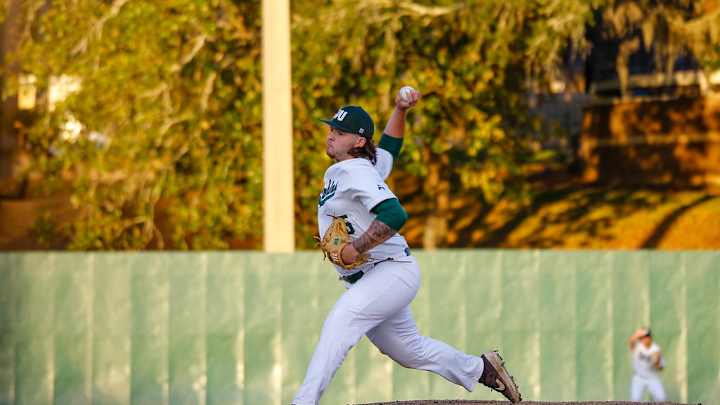Finish Strong: How Blue Jays Prospect Trent Palmer Turned His 2021 Season Around

Trent Palmer bounced off the mound and darted around the TD Ballpark infield, side-stepping teammates and avoiding water crashing out of coolers.
The 22-year-old pitcher couldn’t evade the celebration for long after completing his second seven-inning no-hitter in less than a month. The final seven frames of Palmer's 2021 season dropped his season ERA to 3.00 and capped off a first year of professional baseball full of difficulties and development.
Palmer's first half was stymied by a shoulder injury and plagued by more walks than innings pitched, earning Toronto's 2020 third-round pick “falling” status on Baseball America’s midseason prospect update. But, the second half all but erased the early-season struggles. Key adjustments began to pay off, routines became normalcy, and progress showed on the radar gun and in the statline. Now, Palmer enters 2022 ready to build off his flawless finish.
There’s no one Palmer credits more than Dunedin pitching coach Drew Hayes for "re-teaching” him how to pitch. Missing an early chunk of the season with a bum shoulder and unable to find the strike zone during his first few starts, Hayes and development coach Zach Stewart worked with Palmer to read hitters and break down lineups, imploring him to trust his stuff.
"As the year went on it all started to resonate with me more,” Palmer said. “It benefited me in more ways than I could've imagined.”
For Hayes, however, all the praise goes to Palmer. The 22-year-old truly became a professional during the season, Hayes said, establishing and sticking to his own routines after the Jays talked with Palmer about limiting his workload. After a 7.15 ERA in his first month of starts, Palmer continued to grind. Despite having every Monday off, Palmer would ask Hayes to come in and throw with him. Following the disastrous first five starts, Palmer didn't post an ERA over 2.5 in any other month and the success compounded.
"He's a pretty confident kid to start with,” Hayes said. “But I think he really started to see how good his stuff was. Just how good he can be."
It's hard to tell if a pitcher's stuff plays until they throw it in the zone, and that was Palmer’s problem early on. He had 24 walks and hit three batters in his first 24.1 innings pitched. In his final 38.2 innings of 2021, Palmer walked just 16. There was some drill work involved in refining Palmer’s command, but the main component was mindset and confidence—confidence in his pitches and confidence to rebound if a pitch gets hit.
Listed at 6-foot-1, 230 pounds, Palmer is a presence on the rubber. Coming out of college he described himself as a "bull in a china shop" on the mound. Now, his focus is being calm and in control.
If someone hits a double off him, Palmer reflects on it, figures out why it happened, then lets it go. If he gets worked up, Palmer feels jittery and starts to overthrow—the breaking balls don’t break and the command turns wild. All his pitches won't always be working, so when things aren’t on Palmer now remains poised and figures out how to get strikes that day.
“The biggest thing is just competing,” Palmer said. “Whether you have your good or your bad stuff, just keeping the same mindset.”
Finding a pitch that’s on each start became easier for Palmer last year after adding a new weapon, one even more deadly than his other offerings. Ahead of his first full season, Palmer was messing around on the mound, mixing in a new circle grip with his usual split change. Hayes walked over during the throwing session and asked Palmer what he was doing.
“Have you ever thrown that in a game,” Palmer recalls his coach asking.
When Palmer told him no, Hayes got him to throw it in one of his first recorded bullpens. When the pitch modeling numbers came back, corroborating the nastiness Hayes noticed in real-time, the circle change was officially added to Palmer’s arsenal—and not just as a secondary weapon. The Blue Jays wanted Palmer to find moments for the change, at any point in the count, asking him to throw it over 30% of the time.
Palmer’s new changeup became a weapon to steal an early strike or nab a late swing and miss with ample arm-side run. But, like with the fastball, the key remains getting it in the strike zone.
The new pitch selection and improved control collided in two late-season seven-inning doubleheaders, flashing Palmer's potential. After six innings in a late-August outing, Palmer walked around the Dunedin dugout, aiming to stay loose by chatting with his teammates. Instead, the righty was met with a nervous energy and guys reluctant to chat. A look at the scoreboard’s hit column reminded Palmer why. Three strikeouts later, Palmer pitched his first no-hitter, at any level.
First 7-inning no no since 1979 👀 @palmer2413 pic.twitter.com/jHH43WC3lU
— Dunedin Blue Jays (@DunedinBlueJays) August 20, 2021
“It was pretty exciting,” Palmer said. “From the struggles of the beginning of the year just to see how far I'd come. It was rewarding.”
Four weeks later, the same nervous energy intensified in the Dunedin dugout after six no-hit frames. This time, Palmer knew why. “Is this really happening again,” Palmer asked himself as he sat down the final three batters for his second no-no in less than a month.
In those two no-hit starts and the three outings in between, Palmer worked 29 innings, allowing just six earned runs while striking out 41 and walking 13. It was a perfect finish to an imperfect first season, and now Palmer enters 2022 looking to build. The righty isn’t one to shoot for specific achievements or set statistical benchmarks, but moving forward he has two goals: More strikeouts, fewer walks.
Another no-hitter might be asking too much.
